Understanding What a PBX System is and How it Benefits Your Business
Your story must be something like this. You founded a startup or a business and worked hard against all the odds. You invested your days and nights and everything in between to make sure your business grows.
You kept breaching targets and raising the bar. The business kept growing and so did the number of your team members.
Congratulations! You’ve done well.
Then you realized, you have a big team and you need a communication solution to enable them to communicate within the firm and with clients and the outside world.
You Googled for a solution and you came across something known as a “PBX” System. The only problem now is you don’t know what a PBX is and what it does.
Well, you have nothing to worry about. We’ll help you understand everything about a PBX and even help you choose one.
What is a Private Branch Exchange (PBX) System?
A Private Branch Exchange, commonly abbreviated as PBX is a private telephone network within an organization. It allows users to communicate within the organization.
It also handles the routing of all inbound and outbound communications while providing advanced calling features such as conference calls, interactive voice response and much more.
Before we get to know the features and functions of a PBX, let’s explore the different types of PBX systems.
Types of PBX Systems
PBX systems come in different sizes, shapes and configurations. Choosing one comes down to what your business requires in terms of communication capabilities and cost.
Analog (Traditional) PBX Systems
An analog PBX system connects all internal phones using copper wires and Rj11 connectors. The internal call routing works seamlessly as with any other PBX.
It connects you to a traditional telecom provider and routes your outbound calls through the Plain Old Telephone Service (POTS).
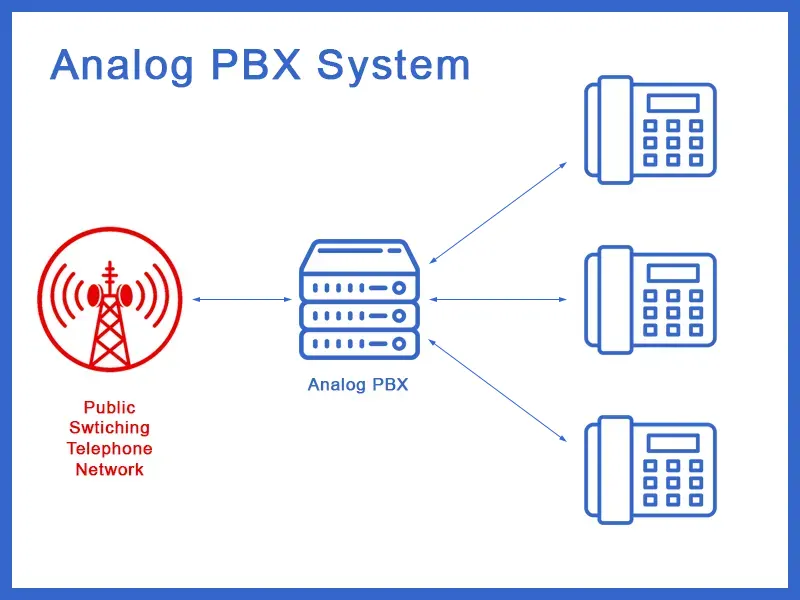
The traditional PBX system is not as capable as its digital counterparts. However, it is a suitable option in case your business operates from a region where internet connectivity isn’t available.
A traditional PBX still offers you the following capabilities:
- Voicemail
- Call Forwarding
- Extensions
- Transfers
- Speed Dial
- Mute
- Digital Answering Assistant
On-Premise VoIP PBX System
A subsequent upgrade in terms of capabilities and user experience is an On-premise VoIP PBX system. Instead of using the POTS running on copper wire, this system makes use of the Internet.
You can deploy this system over the existing internal computer network of your firm. The audio quality, call stability and other metrics experience a huge jump with this system.
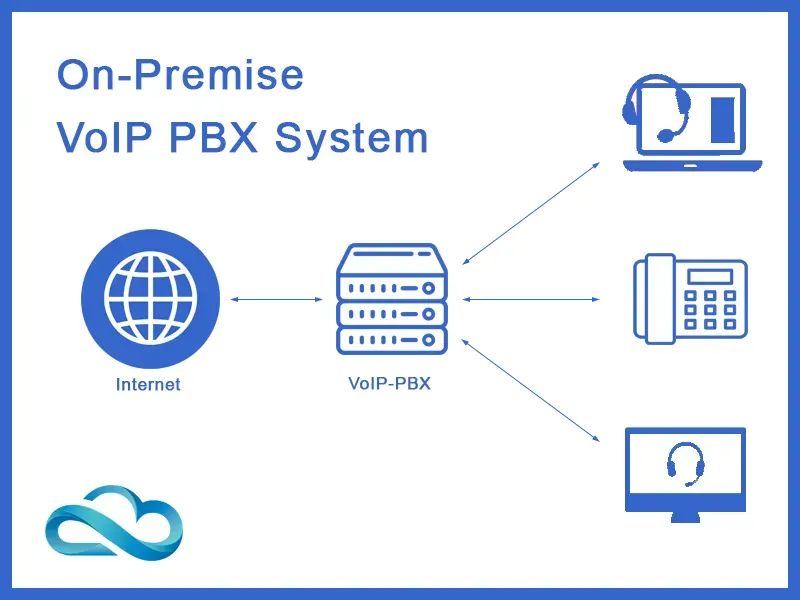
Here are the features and capabilities an On-Premise PBX System system provides in addition to those provides by a traditional PBX system:
- Video calling
- Mobility integration
- Voicemail to email
- Call-back capability
- Auto Attendant
- Caller ID and Call waiting
The initial setup cost of an On-Premise VoIP PBX System is higher compared to a traditional PBX system. However, the cost of operation is significantly lower with industry experts reporting savings of over 50%.
Compared to a traditional PBX, these systems are easy to maintain and manage.
Cloud-based PBX System
Cloud computing has revolutionized almost everything. You can run almost everything on the cloud and a PBX system is no exception.
As the name suggests, a cloud-based PBX system runs off-site on the cloud, managed and maintained by a VoIP service provider such as ConnexCS.
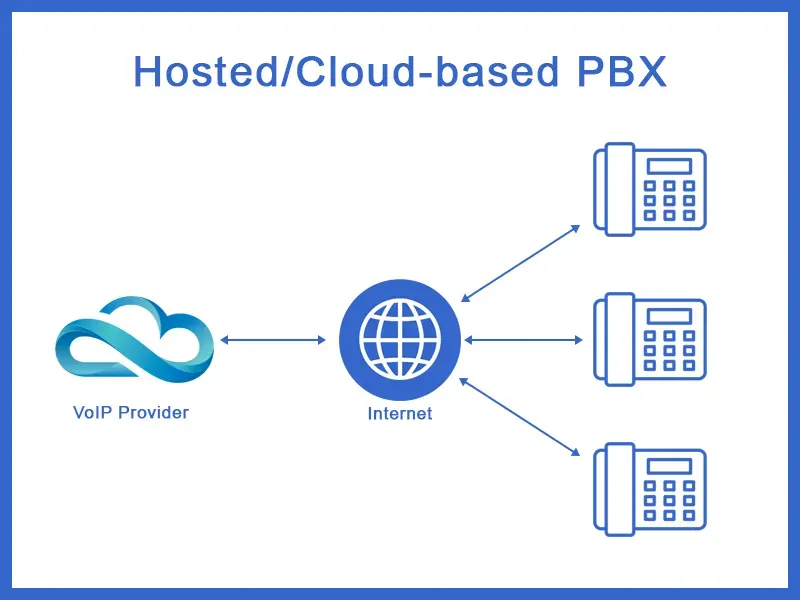
The biggest advantage of a cloud-based PBX system is that there are no initial set-up costs involved. This means you only have to pay for the usage and there are multiple types of service plans you can use from.
Cloud-based PBX systems are not only a suitable option for small businesses but also a good option for enterprises.
You have access to all features that any VoIP PBX provides. Additionally, you benefit from frequent security updates, the latest software updates and additional features.
Hybrid PBX System
In case you’ve already invested in/or already using an analog PBX system and want to enjoy the benefits of VoIP communication, there’s an option for you!
A Hybrid PBX system is a piece of hardware that plugs in and runs on top of your existing analog PBX system.
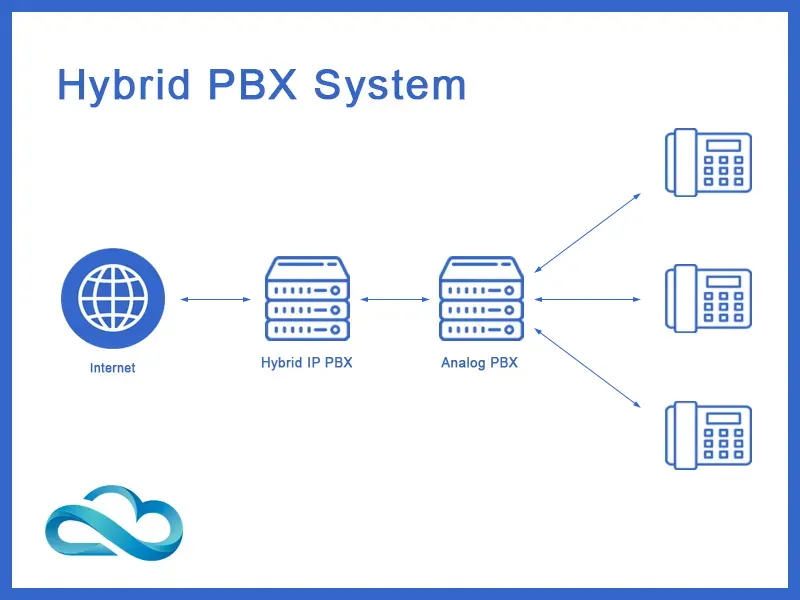
The internal routing and communication remain the same and are managed by the analog PBX. Any outbound or inbound communication from the firm is handled by the Hybrid PBX which operates using VoIP.
This way, you can continue using your traditional PBX system and enjoy the low operation costs of VoIP communication.
Let’s check a PBX System’s features and functions!
Features and Functions of a Cloud-based PBX System
In terms of capabilities, a cloud-based PBX outdoes all other types of PBXs. Let us learn about the top 5 most useful features and functions offered by a cloud-based PBX.
Auto Attendant
An Auto Attendant acts like a virtual receptionist. Let’s consider that your business has a single telephone number. A client wants to talk to a specific software support executive in the customer service department.
The Auto Attendant receives the call and presents options to the caller helping him reach the right person. The caller is required to press digits on the dial pad to choose among those options,
This way the caller reaches the right person.
Interactive Voice Response
Interactive Voice Response is similar to an Auto Attendant but offers more in terms of capabilities and interaction. Unlike an auto attendant, you can directly tell an IVR to route your call to a particular extension or person.
More advanced IVRs come built with conversational AIs. These conversational AIs enable you to offer a lot more features and functions compared to a traditional IVR.
You can deploy a self-help customer portal with extensive menus and troubleshooting guides with an advanced IVR-enabled PBX.
Call Encryption
Scammers are leaving no stones unturned to dupe people of their money and businesses are their top pick. Almost $40 billion was lost to scam calls in the USA just last year.
You can keep your business and customers safe using the call encryption feature available in a PBX system. You have options such as TLS and SRTP when it comes to encrypting all inbound and outbound calls from your business.
Along with the call encryption in our PBX, ConnexCS also provides encryption on all traffic through our Class 4 SIP Cloudswitch for an added level of security.
Intelligent Call Routing and Call Queuing
There are often instances when too many customers call you at the same time. Now you have a limited number of executives to service them but each customer is important.
What do you do now? PBX Systems have intelligent call routing and call queuing functionality. The PBX system will line up all inbound calls in a queue instead of informing your customers that all the support executives are busy at the moment.
The PBX can also inform the customers of the expected wait times and ensure they reach the right person at the earliest.
Call Reporting and Analytics
This one is an especially powerful feature in case your business has extensive customer service/sales operations or you operate a call center.
You will be able to monitor a lot of key performance indicators for your operations. Here are the things you can monitor using a PBX:
- Average call duration
- Call time heat map
- First call resolution
- Top team performers
Having access to this data can help you understand your operations properly. Moreover, you’ll be able to generate a lot of insights and improve your operations.
Want to learn about more features? Check out our product page!
Benefits of using a Cloud-based PBX
We’ll be considering the 5 most significant benefits of opting for a cloud-based PBX.
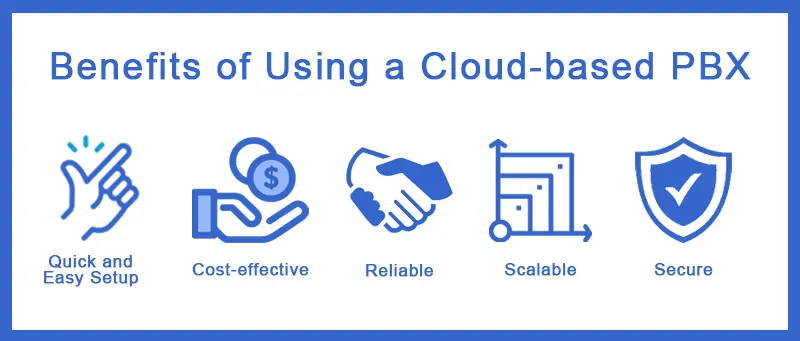
Let’s get started then, shall we?
Easy Deployment
Be it an analog PBX, on-premise IP PBX or any other type of PBX, these take time and carry additional setup and deployment costs.
The setup process is often complex and might require you to hire a communication systems engineer to keep everything running smoothly.
Compared to these systems, a cloud-based PBX is not only easy to setup and deploy but does away with the setup and deployment costs.
Thus, not only is the deployment of a Cloud-based PBX easy and quick but also saves your firm a lot of money.
Cost-effective
There are three fronts where you save your business a lot of money when you opt for a Cloud-based PBX.
- There are no initial setup costs involved as in the case of an On-premise PBX.
- You enjoy the cost benefits of using VoIP for communications.
- The maintenance and upkeep are the responsibility of the provider.
Thus, your business not only saves a lot of funds but also enjoys the other benefits that will be mentioned after this.
Reliability
An on-premise PBX has multiple hardware failure points. You don’t have to deal with any of those when you opt for a cloud-based PBX.
Your internet connection will remain a failure point still. However, the same is also true for any on-premise VoIP PBX.
Moreover, a cloud-based PBX gets timely software updates and new features. This provides more stability and utility to your communication.
Scalability
Any form of on-premise PBX restricts your operational scalability due to hardware restrictions. To scale operations, you will have to invest in more hardware.
This isn’t the case for a cloud-based PBX. As the PBX operates on the cloud, you can enjoy rapid scalability on demand.
Moreover, many service providers offer usage-based plans. Thus, you won’t have to worry about anything and only pay as per your usage.
Enhanced Security
Any cloud-based service or software usually offers a higher degree of security in comparison to an on-premise system.
You get more options in terms of network protocols, levels of encryption, etc. compared to using an on-premise system.
Moreover, changing from one protocol/encryption to another can be done in a few clicks. Cloud servers are constantly updated with the latest security patches.
This makes sure they’re not vulnerable to any security exploits that an on-premise system might fall victim to.
Conclusion
Technological development improves your business in more ways than one. Communication happens to be one area where technology has made a lot of amazing things possible.
A Cloud-based PBX can improve your business’s communication, keep you secure, lower your operational costs and position you well for the era of remote work and work from home.
Want to experience all these benefits? Signup for a free trial of your Cloud PBX!
























































































































